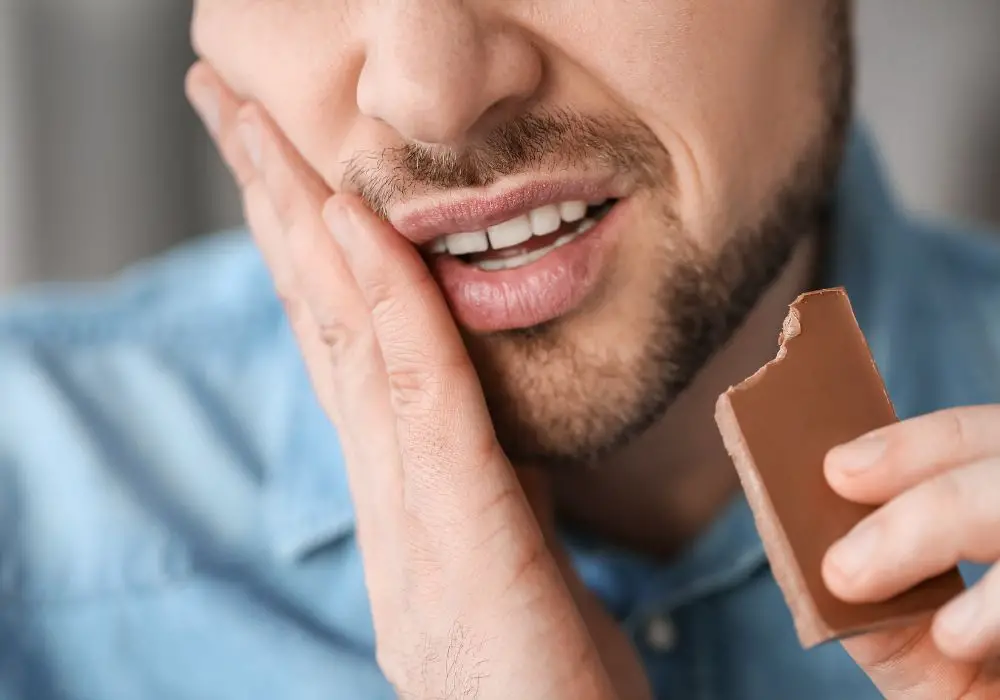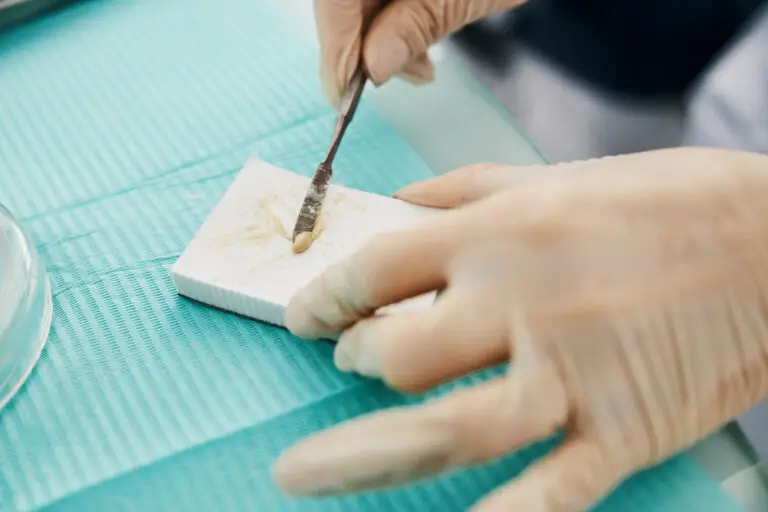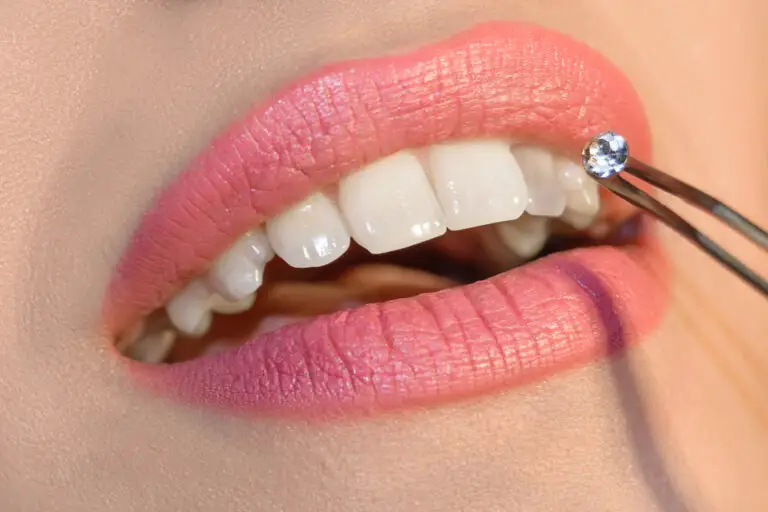What causes tooth sensitivity when eating?
Teeth can become sensitive and ache when eating for several reasons:
1. Exposed dentin
The tooth has a layered structure made up of an outer enamel layer that covers and protects the inner dentin layer. Dentin contains thousands of microscopic tubules leading down to the pulp and nerve of the tooth.
Enamel can wear away or decay over time, allowing dentin underneath to become exposed. When this happens, temperature changes, air, liquids, or pressure during eating can stimulate the nerve endings in the exposed dentin tubules, causing sharp pain.
Common causes of exposed dentin include:
- Tooth decay – Bacteria produce acids that break down enamel and dentin, leading to cavities that require fillings. Decay around the gum line is a common culprit of sensitivity.
- Gum recession – Gums recede down the tooth, exposing vulnerable root surfaces covered with only a thin layer of cementum instead of enamel. This causes dentin exposure near the gum line.
- Cracks or chips in teeth – Cracks allow external stimuli to penetrate to the inner dentin layer. Cracks are often very small and hard to see on the tooth surface.
- Worn down enamel – Using a hard-bristled toothbrush and abrasive paste can over-brush and erode enamel over time. Acidic foods also contribute to erosive wear.
- Abrasion – Habits like aggressive tooth grinding wears down enamel and dentin.
2. Dental procedures
Many routine dental treatments and tooth whitening procedures can cause temporary sensitivity by irritating the inner dentin layer:
- Professional teeth cleaning can make teeth sensitive for a few hours up to several days after the procedure.
- Tooth-colored fillings and other restorations may provoke sensitivity as they settle into place.
- Root canal treatment can inflame the inner pulp space, causing temporary sensitivity while it heals.
- Teeth whitening solutions and whitening strips often contain peroxide that penetrates the enamel and dentin, increasing sensitivity for 1-2 weeks.
3. Bruxism
Clenching the jaw or grinding teeth, especially during sleep, puts excess force on teeth over time. This can wear down the enamel layer and expose sensitive dentin. It also may crack teeth, allowing hot/cold stimulation to reach the pulp. Wearing a customized night guard helps protect teeth from further damage during grinding.
4. Gum disease
Chronic gum inflammation from gingivitis or advanced periodontitis causes the gums to recede down from the teeth. This exposes vulnerable root surfaces that have much less enamel covering. Gum recession due to periodontal disease is a major reason for root sensitivity. Treating and controlling gum disease helps reduce sensitivity.
5. Orthodontic treatment
Teeth may become extra sensitive during orthodontic treatment as they shift and settle into new positions. During this time, the teeth are also more vulnerable to decay. Careful oral hygiene and fluoride use helps minimize sensitivity from braces.
6. Cracked teeth
Unseen cracks in teeth allow hot or cold air and food to penetrate to the inner dentin and pulp, causing sharp pain when biting down. While cracks may not be visible from the surface, they can provoke extreme sensitivity and require dental treatment.
When does tooth sensitivity during eating occur?

Sensitive teeth typically react when eating foods or drinking beverages that are:
- Very hot or very cold – Temperature extremes provoke sharp pain in exposed dentin and pulp nerves.
- Sweet, sour, or acidic – Sugary or acidic foods chemically irritate exposed dentin. Acids also soften enamel over time, worsening sensitivity.
- Crunchy, sticky, or hard – Firm pressure on teeth pushes external stimuli into sensitive areas, causing pain. Hard foods like nuts, crackers, ice, popcorn can provoke sensitivity when chewing.
The severity of pain ranges from mild zings to intense, stabbing pains. It most often affects the front teeth and back molars but can occur in any tooth with exposed dentin.
Sensitivity may happen immediately when consuming the problematic foods or can have a delayed reaction shortly after eating.
How is tooth sensitivity diagnosed?
Dentists use several diagnostic tools to pinpoint the cause of eating-related tooth sensitivity:
- Discussion of medical and dental history – Your dentist will ask about any symptoms, oral habits like grinding, dietary acid intake, and previous dental treatments.
- Visual dental examination – The dentist checks for visual signs like tooth decay, cracks, chips, excessive wear, or receding gums that may be causing sensitivity.
- X-rays – Dental x-rays detect issues between teeth or below the gum line that cannot be seen on a surface exam. Cavities, lost bone, or other problems show up.
- Cold air test – A gentle stream of cold air is blown on each tooth to help isolate areas of sensitivity.
- Percussion test – Teeth are lightly tapped to check for exaggerated response to pressure indicating inner tooth problems.
- Cold stimulation test – A cold instrument or ice is held against tooth surfaces to provoke symptoms in sensitive spots.
- Cavity detection dye – Colored dye applied to the teeth absorbs into demineralized areas indicating decay, including below the gum line.
If your dentist cannot determine the exact cause or best treatment, you may be referred to an endodontist (root canal specialist) for further diagnosis.
What are treatments for sensitive teeth from eating?

A number of treatment options exist to reduce or eliminate tooth sensitivity depending on the cause:
In-office treatments
Several procedures and products applied by your dentist can relieve sensitivity:
- Fluoride varnish – A paste containing a high concentration of fluoride is “painted” on teeth to strengthen enamel and make it more resistant to decay and sensitivity.
- Gluma desensitizer – An agent applied to sensitive root surfaces to numb and desensitize the area.
- Sealants – Thin plastic coatings that adhere to the chewing surfaces of back teeth to shield them from sensitivity. Effective for teeth with pits and fissures.
- Root planing – Deep cleaning treatment for gum recession to remove bacteria and deposits from exposed roots.
- Gum grafting surgery – A periodontist can surgically graft gum tissue over areas of recession to cover exposed roots and block sensitivity.
- Fillings or crowns – Teeth with decay, cracks, or excessive wear require protective restorations to stop sensitivity, prevent pulp exposure and infection.
- Pulp capping – Covering exposed pulp with a medicated agent to encourage healing and dentin growth.
- Root canal – If the pulp becomes irreversibly inflamed from decay or cracks, a root canal removes the inner pulp and nerves.
At-home remedies
There are several over-the-counter products you can use at home to manage sensitive teeth:
- Sensitive toothpaste – Look for active ingredients like stannous fluoride, potassium nitrate, or strontium chloride that work inside the tooth to block sensitivity. Use twice per day.
- Desensitizing mouthwash – Reduces nerve sensitivity chemically when swished around sensitive teeth. Rinse daily.
- Fluoride rinse – Daily rinsing with fluoride strengthens enamel to protect dentin underneath.
- Desensitizing strips or gel – Applied to sensitive areas to numb the tooth surface nerves temporarily.
- Oral analgesic – Pain relief gel with lidocaine or benzocaine can provide temporary numbness and pain relief on irritated areas.
Dietary changes
Adjusting your eating habits can reduce pain from sensitive teeth:
- Avoid acidic foods like citrus fruits, tomatoes, vinegar that provoke sensitivity.
- Drink cold or hot beverages with a straw directed away from sensitive surfaces.
- Limit sugary foods that seep into exposed areas.
- Choose non-abrasive toothpaste and brush gently to prevent wearing down enamel.
- Don’t brush immediately after eating acidic foods, rinse first with water.
Proper oral hygiene
Practicing excellent oral care every day prevents issues leading to sensitivity:
- Use proper brushing and flossing technique.
- Choose a soft-bristled toothbrush.
- Use gentle motions and avoid aggressive scrubbing.
- Pick toothpaste with fluoride and natural abrasives like silica.
- Have regular professional cleanings every 6 months to prevent decay and disease.
When to see a dentist?

Consult your dentist promptly if tooth sensitivity:
- Develops suddenly after a dental procedure.
- Worsens significantly or persists more than 2-3 weeks.
- Impacts your ability to eat comfortably.
- Is provoked by hot and cold stimuli – a sign of inner pulp inflammation.
- Radiates pain toward the ear, eye, sinus, or side of the face – may indicate cracked tooth or dental abscess.
Seek emergency dental care if you have prolonged, severe toothache that disrupts sleep or keeps you from eating. Sudden onset of sensitivity can mean an underlying dental problem needing immediate treatment.
Frequently Asked Questions
Why are my teeth sensitive to sugar but not cold?
Sugar sensitivity usually indicates decay or erosion at the gum line or between teeth where it’s hard to clean. The sugar causes irritation in these unprotected areas. Cold sensitivity suggests exposed dentin on chewing surfaces or cracks allowing stimuli deep into the tooth interior. Teeth react to hot/cold, sweet, air, pressure, acids, etc. depending on where the dentin is exposed.
Can sensitive teeth be a sign of other problems?
Yes, sensitivity can indicate issues like:
- Dental abscesses – bacterial infection from untreated decay destroys inner tooth tissue
- Cracked or fractured teeth – cracks allow deep penetration to the pulp
- Cavities building under old fillings or below the gum line – harder to detect
- Receding gums or gum disease – exposes sensitive root area
- Pulp inflammation – signals dying or inflamed nerve
Let your dentist thoroughly evaluate any persistent or recurring sensitivity to determine if further treatment is required.
How long does eating-related tooth sensitivity last?
Duration depends on the cause. Sensitivity from dental work may resolve in a few weeks as the tooth recovers. For issues like worn enamel or gum recession, symptoms can come and go unless properly treated. Using at-home remedies provides temporary relief but does not address the underlying problem. See your dentist to find a long-term solution for ongoing sensitivity.
Should I avoid eating on the sensitive side of my mouth?
It’s fine to keep eating on that side while using desensitizing treatments, just avoid foods/beverages that you know will cause pain. Biting pressure and temperature extremes provoke the most sensitivity. Supplement with over-the-counter pain medication as needed for discomfort but don’t ignore any persistent or worsening sensitivity.
What home remedy works best for sensitive teeth?
Daily use of a sensitivity toothpaste containing ingredients like stannous fluoride, arginine, or potassium nitrate works best. These active ingredients treat sensitivity by blocking nerve transmission in the dentin tubules. Combining this with a soft toothbrush, fluoride mouthwash, and limiting dietary acids gives the most effective home relief. See your dentist if OTC remedies are inadequate.
In summary
Tooth sensitivity while eating has many potential causes. The most common include gum recession, worn enamel, cracks, and dental procedures. Symptoms range from mild to sharp pain provoked by hot, cold, sweet, or pressure during eating. Professional treatment is needed to address the source of sensitivity for long-term relief. Excellent oral hygiene and home care products can manage discomfort until underlying causes are corrected. Work with your dentist to ensure any persistent tooth sensitivity is properly diagnosed and treated.







